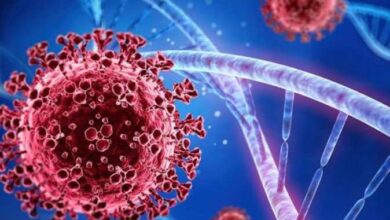
An Egyptian scientist named Mohamed Rahim is among the members of a research team at the University of Lancaster in the UK who have succeeded in designing a new vaccine against the coronavirus.
This was done through a new technique called “reverse genetic engineering” from fertilized eggs and a vaccine for poultry, which is taken intranasally and at a lower cost than existing vaccines.
According to Sky News Arabia, Rahim said that the results of ongoing research of vaccine trials tested on animals confirmed the ability of the new vaccine to prevent infection and stop the virus from affecting the lungs.
Rahim added that if the new vaccine passes clinical trials on humans, it will surely bring about a new shift in controlling the COVID-19 pandemic, as it is safe and easy to administer through the nose in addition to the low cost of production compared to other vaccines.
The team has been working on the vaccine since late 2019, he said, and were finally able to create a vaccine that fights the virus at its place of entry – the respiratory system, especially the nose.
Rahim explained that the biggest challenge for the research team was ensuring that the vaccine was safe for humans, cheap and easy to provide for developing and poor countries.
He says the idea for this vaccine came when he suggested to his director that reverse genetic engineering technology be used to produce a vaccine.
The idea was applied on the Newcastle Disease Virus vaccine, used to vaccinate poultry in Egypt for decades.
The impressive results achieved by materials used in this vaccine to treat some types of cancer over the past 20 years, and the ease of dealing with these materials in laboratories were the main factors behind using it to manufacture the new vaccine, he explained.
Rahim’s team began designing the vaccine through monitoring circulating or existing viruses and then designing an antigen part called a “spike protein”. The antigen is responsible for stimulating the immune system to produce immune bodies against the coronavirus.
They began to part of this virus into the Newcastle poultry virus, he said, and moved to conducting conduct laboratory experiments and work on producing the spike protein to fight the coronavirus.
Rashim added that the new vaccine does not need specific factories or expensively equipped laboratories, and can be made in the same laboratories that produce influenza vaccines.
Soon after the World Health Organization was addressed to record the vaccine, clinical trials were conducted on animals to fully verify the effectiveness of the vaccine in stimulating their immune system.
The vaccine was effective in stimulating immune system without any risks, building up a strong immunity against the virus within the animal subjects.
Rahim said that the low cost of this vaccine will help developing and poor countries eradicate the coronavirus without the need of other countries, as this vaccine can be produced using fertilized eggs.
One egg can be enough to produce than one vaccine dose, he said.
The price of an egg ranges between LE10 and LE15, he said, pointing out that an Egyptian government farm for eggs free of pathogens is already present in Fayoum Governorate and could be used to make the vaccine.
The research team is waiting for the approval of the World Health Organization to start conducting clinical trials on humans, Rahim explained, adding that the team is also currently underway to determine the countries in which the vaccine will be tried.
The research team published their first research paper on their experiments in the Vaccines MDPI journal in Basel, Switzerland.
Rahim worked as a teacher at the Department of Virology at the Faculty of Veterinary Medicine at Cairo University, before traveling to the UK on a scientific mission, where he obtained a position as a researcher in virology at the Faculty of Medicine and Life Sciences at Lancaster University in 2019.
The research team that succeeded in creating the coronavirus vaccine from fertilized eggs and a vaccine for poultry is headed by British doctor Mohamed Munir. The team includes other researchers from the same university in addition to a research team from the University of Texas headed by Professor Luis Martinez.




